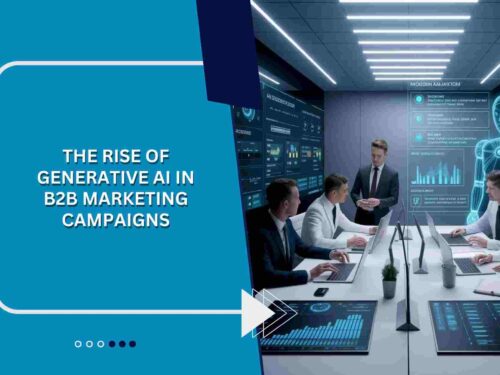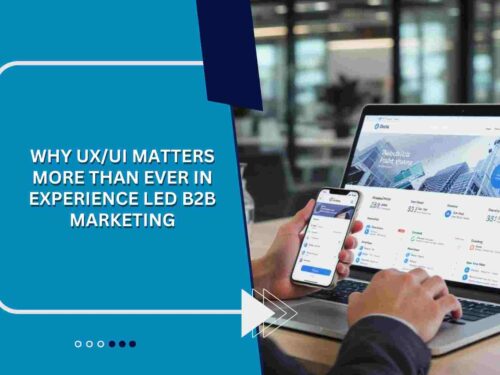As we enter a new era of digital transformation, demand generation is no longer just about lead forms and email blasts. In 2025, businesses are rethinking how they attract, engage, and convert potential buyers thanks to the power of artificial intelligence and marketing automation. With buyers now expecting personalized, real-time experiences, the pressure is on B2B marketers to evolve beyond static campaigns and traditional funnels.
AI and automation are leading this shift. These technologies are enabling smarter decisions, faster execution, and deeper customer insights, ultimately allowing marketers to build scalable and data-driven demand generation strategies. Whether it’s predictive analytics guiding outreach or intelligent chatbots accelerating qualification, the new landscape is built on agility, relevance, and automation at every stage.
This blog explores how AI and automation will reshape demand generation in 2025, the tools and trends driving the shift, and what businesses need to do to stay ahead of the curve.
The Evolution of Demand Generation: From Manual to Machine-Driven
Historically, demand generation relied heavily on human input manual segmentation, hand-crafted email sequences, static lead scoring models, and one-size-fits-all content. While these efforts laid the groundwork for pipeline development, they often lacked scalability, personalization, and real-time relevance.
In 2025, AI and automation eliminate these limitations. AI algorithms now process vast amounts of data in milliseconds, analyzing buyer behavior, preferences, intent, and engagement patterns. Combined with automated workflows, marketers can launch highly targeted campaigns that dynamically adjust based on how prospects interact with content or progress through the funnel.
What once took weeks to plan and execute is now happening in real time, and it’s only getting faster.
Predictive Lead Scoring and Intelligent Segmentation
Traditional lead scoring models use fixed attributes like job title, company size, or email opens. However, they miss the contextual and behavioral nuances that indicate genuine buying intent. AI changes that by applying machine learning to identify patterns from past successful conversions and using that data to prioritize leads dynamically.
In modern demand generation strategies, AI-powered lead scoring tools continuously learn from real-time inputs such as time spent on site, engagement across touchpoints, technographic data, and even sentiment analysis from conversations. These models provide more accurate predictions about which leads are likely to convert and when.
Intelligent segmentation further enhances targeting. Rather than relying on broad personas, AI clusters audiences based on live data points. This means marketers can target micro-segments with hyper-relevant messaging and content dramatically improving conversion rates.
Hyper-Personalized Content Delivery at Scale
Content remains the engine of demand generation, but static eBooks or generalized blog posts no longer cut it. AI and automation now allow marketers to personalize content not only by name or company but by specific intent signals, interests, and buying stage.
Natural language processing and content recommendation engines help tailor experiences in real time. For example, a CMO researching account-based marketing may be shown case studies, pricing calculators, or ROI reports, while a marketing manager might see how-to guides or webinar invites.
Automated content workflows also mean that prospects can receive nurture sequences uniquely curated to their behavior. This level of personalization, once impossible to scale manually, is now executed across thousands of contacts simultaneously—redefining how effective demand generation campaigns are built.
Conversational AI and Chatbots in the Funnel
AI-powered chatbots are taking center stage in modern demand generation strategies. No longer confined to basic FAQ roles, these intelligent bots qualify leads, book meetings, suggest content, and even assist with product education all in real time.
Conversational AI uses natural language understanding to engage prospects in meaningful discussions. Whether it’s a website visitor exploring pricing or a returning user interested in product updates, the bot adjusts its responses based on previous interactions, intent signals, and CRM data.
The result is a frictionless, always-on demand engine. Leads are no longer lost during after-hours or while waiting for a follow-up email. Instead, they move through the funnel faster, guided by real-time AI interactions that mimic human sales engagement—without human delay.
AI-Driven ABM Campaigns for Precision Targeting
Account-based marketing (ABM) is one of the most powerful demand generation strategies in B2B, and AI is amplifying its impact. By analyzing firmographic, technographic, and intent data, AI identifies which accounts are in-market and recommends the best channels, messages, and timing for engagement.
AI can also uncover buying group behavior across departments within a single account helping marketers orchestrate multichannel campaigns that address different personas with tailored messaging. Automated workflows then deliver this content via email, social, programmatic ads, or direct mail, depending on the user’s interaction history.
In 2025, ABM powered by AI is not only more effective but also more scalable. Businesses can now run dozens of simultaneous ABM campaigns without sacrificing personalization or strategy ensuring maximum ROI from every target account.
Automated Campaign Orchestration and Journey Mapping
Manually setting up multi-touch campaigns, tracking engagement, and updating lead stages is time-consuming and error-prone. Automation platforms powered by AI now orchestrate entire demand generation campaigns across channels with minimal human intervention.
Modern marketing automation tools monitor every touchpoint emails, web visits, ad clicks, event registrations and adjust the next best action based on user behavior. If a lead downloads a whitepaper, the system might trigger a product demo invitation. If they don’t engage for a few days, it may send a reminder or show a retargeting ad.
This dynamic journey mapping allows marketers to guide prospects through personalized funnels while focusing their efforts on strategy and optimization instead of manual execution.
Real-Time Analytics and AI-Powered Insights
Data without insight is useless. AI takes demand generation analytics to a new level by turning performance data into real-time, actionable intelligence.
Instead of waiting until the end of a campaign to see results, marketers can now receive instant insights into which headlines are performing, what subject lines drive opens, or which content assets lead to conversions. Machine learning models highlight anomalies, suggest optimizations, and even predict campaign success before it concludes.
This means marketers can adapt on the fly, reallocating budget, shifting messaging, or adjusting audience segments to improve outcomes in real time.
AI analytics also enable better attribution modeling connecting top-of-funnel efforts like blog content or paid ads directly to pipeline generation and revenue. This clarity is crucial for optimizing demand generation ROI and making smarter strategic decisions.
Intent Data and AI for Buyer Readiness Signals
One of the most transformative developments in 2025 is the integration of third-party intent data into AI-driven demand generation strategies. By analyzing digital footprints such as topic searches, competitor visits, and content consumption AI can identify when prospects are entering the buying cycle.
Combined with first-party behavioral data, this allows marketers to create highly timely campaigns. A prospect researching product comparisons on third-party sites can trigger automated outreach with comparison guides, testimonials, or pricing calculators all orchestrated by AI.
This proactive approach turns marketing into a predictive engine rather than a reactive one significantly improving conversion rates and shortening sales cycles.
Reducing Friction Between Marketing and Sales
AI-powered demand generation platforms are closing the gap between marketing and sales. Tools that use AI for lead enrichment and scoring ensure sales teams receive higher-quality, sales-ready leads. Automated alerts notify sales reps when prospects take high-intent actions, such as revisiting the pricing page or engaging with product demos.
AI also powers sales enablement content recommendations suggesting which assets reps should use based on a lead’s behavior or persona. This alignment ensures that marketing efforts are directly tied to sales outcomes, creating a more unified and effective revenue engine.
The Human-AI Partnership in Demand Generation
Despite all the advancements, AI and automation do not replace human creativity, empathy, or strategic thinking. Instead, they empower marketers to focus on what truly matters crafting compelling messages, developing high-impact strategies, and building meaningful relationships.
The most successful demand generation teams in 2025 will be those that combine the scalability and intelligence of AI with human insight. Automation handles the heavy lifting; humans deliver the vision and emotional connection.
Want to activate your demand generation with AI and automation? Contact us at Acceligize to future-proof your B2B marketing strategies with data-driven solutions and performance-driven campaigns.




